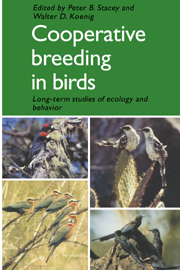Book contents
- Frontmatter
- Contents
- Contributors
- Introduction
- 1 Splendid Fairy-wrens: demonstrating the importance of longevity
- 2 Green Woodhoopoes: life history traits and sociality
- 3 Red-cockaded Woodpeckers: a ‘primitive’ cooperative breeder
- 4 Arabian Babblers: the quest for social status in a cooperative breeder
- 5 Hoatzins: cooperative breeding in a folivorous neotropical bird
- 6 Campylorhynchus wrens: the ecology of delayed dispersal and cooperation in the Venezuelan savanna
- 7 Pinyon Jays: making the best of a bad situation by helping
- 8 Florida Scrub Jays: a synopsis after 18 years of study
- 9 Mexican Jays: uncooperative breeding
- 10 Galápagos mockingbirds: territorial cooperative breeding in a climatically variable environment
- 11 Groove-billed Anis: joint-nesting in a tropical cuckoo
- 12 Galápagos and Harris' Hawks: divergent causes of sociality in two raptors
- 13 Pukeko: different approaches and some different answers
- 14 Acorn Woodpeckers: group-living and food storage under contrasting ecological conditions
- 15 Dunnocks: cooperation and conflict among males and females in a variable mating system
- 16 White-fronted Bee-eaters: helping in a colonially nesting species
- 17 Pied Kingfishers: ecological causes and reproductive consequences of cooperative breeding
- 18 Noisy Miners: variations on the theme of communality
- Summary
- Index
13 - Pukeko: different approaches and some different answers
Published online by Cambridge University Press: 07 September 2010
- Frontmatter
- Contents
- Contributors
- Introduction
- 1 Splendid Fairy-wrens: demonstrating the importance of longevity
- 2 Green Woodhoopoes: life history traits and sociality
- 3 Red-cockaded Woodpeckers: a ‘primitive’ cooperative breeder
- 4 Arabian Babblers: the quest for social status in a cooperative breeder
- 5 Hoatzins: cooperative breeding in a folivorous neotropical bird
- 6 Campylorhynchus wrens: the ecology of delayed dispersal and cooperation in the Venezuelan savanna
- 7 Pinyon Jays: making the best of a bad situation by helping
- 8 Florida Scrub Jays: a synopsis after 18 years of study
- 9 Mexican Jays: uncooperative breeding
- 10 Galápagos mockingbirds: territorial cooperative breeding in a climatically variable environment
- 11 Groove-billed Anis: joint-nesting in a tropical cuckoo
- 12 Galápagos and Harris' Hawks: divergent causes of sociality in two raptors
- 13 Pukeko: different approaches and some different answers
- 14 Acorn Woodpeckers: group-living and food storage under contrasting ecological conditions
- 15 Dunnocks: cooperation and conflict among males and females in a variable mating system
- 16 White-fronted Bee-eaters: helping in a colonially nesting species
- 17 Pied Kingfishers: ecological causes and reproductive consequences of cooperative breeding
- 18 Noisy Miners: variations on the theme of communality
- Summary
- Index
Summary
New Zealand has at least eight species of birds that regularly have more than a breeding pair involved in nesting and rearing of young. One is a sea bird (the Southern Skua, Stercorarius lonbergi), others are small forest insectivores (the Whitehead, Mohoua albicilla; the Yellowhead, Mohoua ochrocephala; the Brown Creeper, Finschia novaeseelandiae; and the Rifleman, Acanthisitta chloris), while the remainder are rails (Takahe, Notornis mantelli; Weka, Gallirallus australis; and the Pukeko, Porphyrio porphyrio). The range of environments occupied (from sub-Antarctic to subtropical, from oceanic islands to dense evergreen forests and from alpine grasslands to lowland swamps), the range in size (from our smallest to some of our largest species), and the range in demography (from short-lived to long-lived birds that rarely breed before the age of nine years) make the quest for a universal explanation of cooperative breeding a difficult task indeed.
Pukeko have the most complex social system of all these species. (Pukeko is the Maori name for this gallinule, which is known as the Swamphen in other places.) Most Pukeko are found in communal groups of up to a dozen birds. All participate to a greater or lesser extent in the rearing of chicks and the defense of the territory. Birds are capable of breeding from one year of age but most do not until at least three years of age.
- Type
- Chapter
- Information
- Cooperative Breeding in BirdsLong Term Studies of Ecology and Behaviour, pp. 385 - 412Publisher: Cambridge University PressPrint publication year: 1990
- 21
- Cited by

